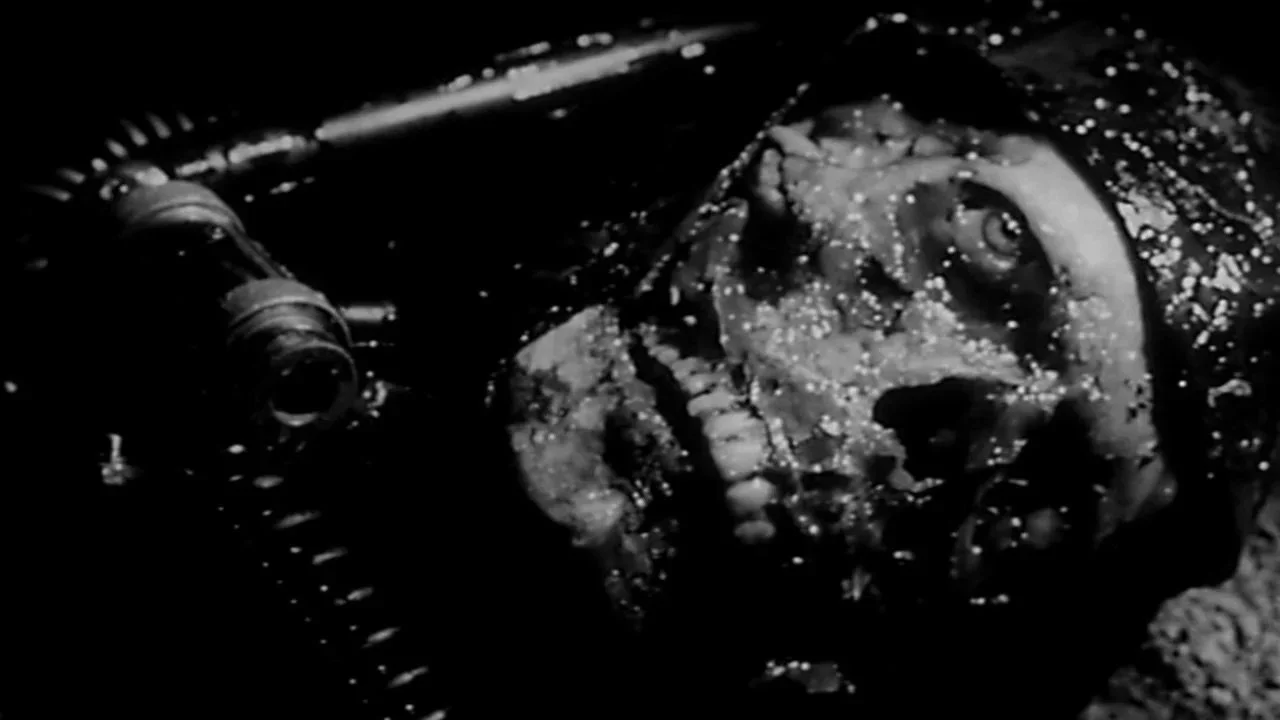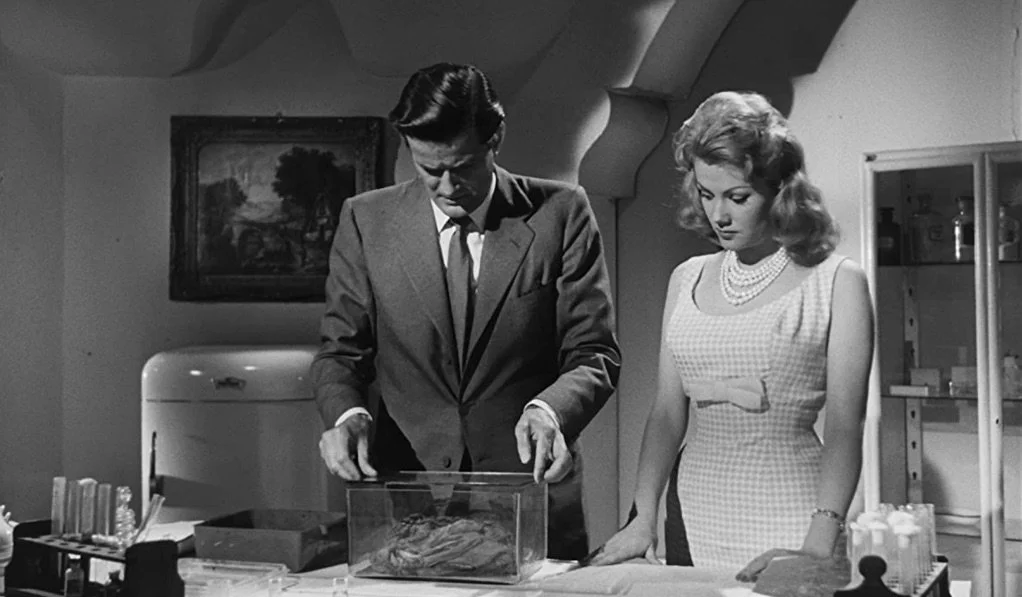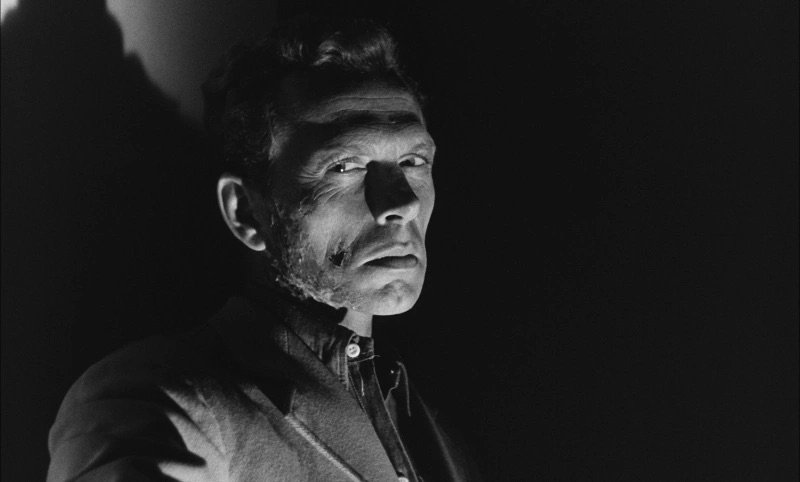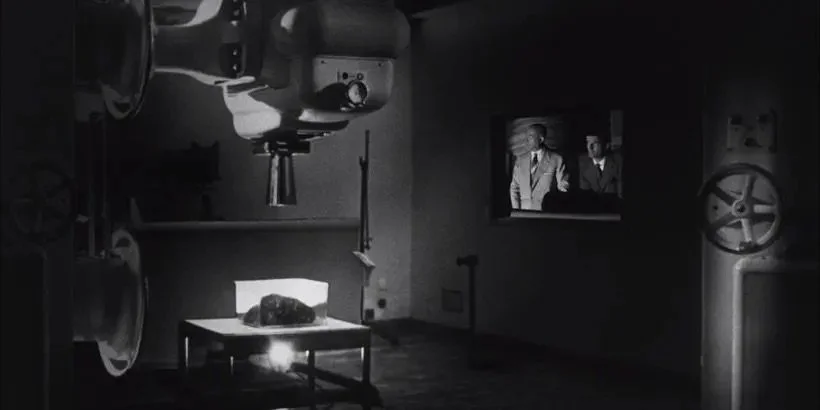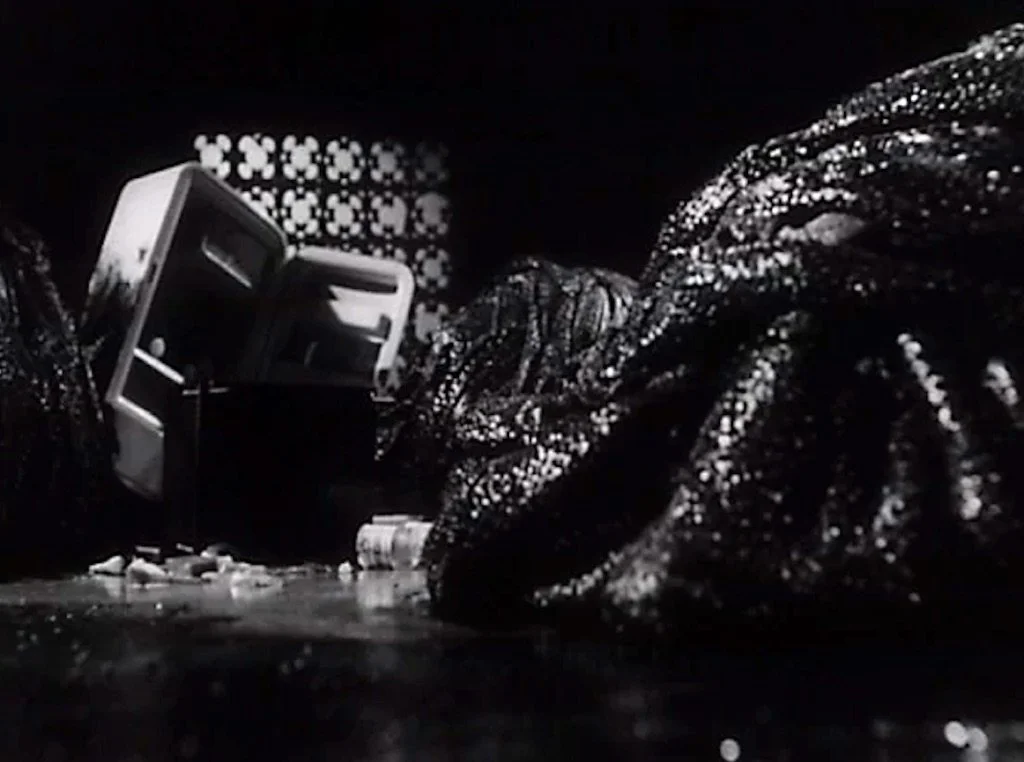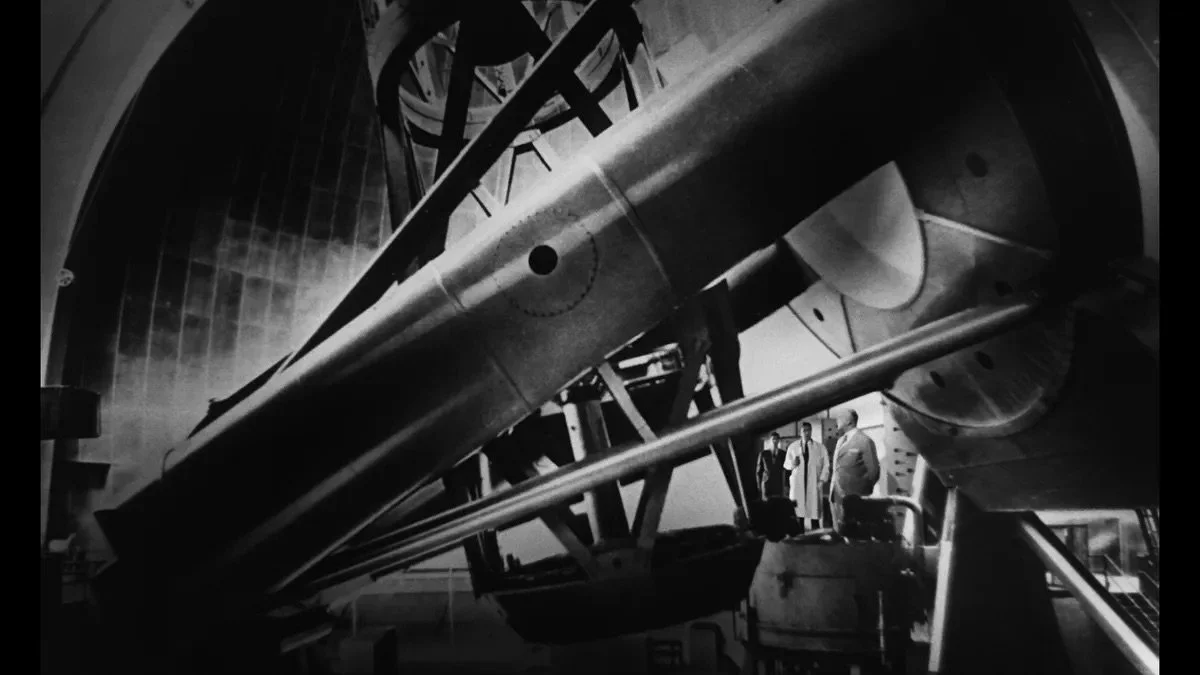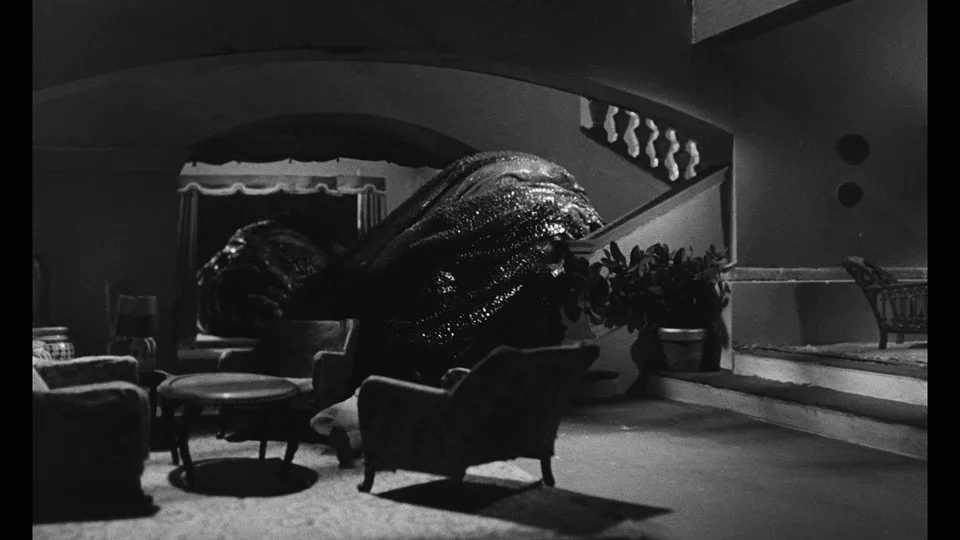Caltiki, the Immortal Monster/Caltiki il Mostro Immortale (1959)
An Amorphous Monsters Feature
As monster kids and classic sci-fi movie fans will tell you, the 1950s featured a cinematic onslaught of robots, aliens, and atomic age monsters of all shapes and sizes—massive reptilian beasts, tiny men, 50-foot ladies, huge bugs, gill men, wasp women, rock monsters, and more. In the middle of the decade a brief yet impactful little sub-genre emerged: the amorphous monster movie. These films were all the rage, the drive-in screens awash with sliding, oozing, slithering creatures of non-committal shape. The genesis of these faceless and limbless terrors varied as some were born of radiation, some were extraterrestrial, and some were of subterranean origin.
The four films we’ll be covering in this series feature a slice of the amorphous monster cinema, but they do represent an international array of productions from the U.K., Japan, the U.S., and Italy, where our tour begins.
A Monstrous Discovery
Approximately 300 miles from Mexico City, a team of archaeologists led by British Professor John Fielding (John Merivale) is exploring the ruins of a vanished ancient Mayan civilization. Along on the expedition is Fielding’s wife Ellen Fielding (Didi Sullivan), fellow archaeologist and friend Max Gunther (Gerard Haerter), Max’s girlfriend Linda (Daniela Rocca), and assorted other team members and indigenous peoples. Fielding, Max, and team are in the field trying to unlock the mystery as to why an ancient civilization abandoned the city of Tikal back in 607 CE. They learn through ancient texts and lore passed down through generations that their ancestors left Tikal’s homes, temples, and pyramids to escape the wrath of a terrible, bloodthirsty goddess known as Caltiki.
Complicating matters is Max’s lustful gaze and covetous behavior towards Ellen, who he wants for himself. He doesn’t seem to sweat the fact that he has a girlfriend and that the object of his desire is his friend and colleague’s wife. Yes, Max is a jerk and a bit of a sleaze. But let’s get back to the expedition.
The archaeologists make their way through the jungle and discover a deep network of caves, one of which houses a sacred temple dedicated to Caltiki and an underground lake where the Mayan priests made sacrificial offerings to the goddess. Our team also finds precious jewels and other ancient artifacts around the cavern and at the bottom of the lake.
While Fielding urges caution, a fellow archaeologist and overzealous treasure hunter takes a dive in the lake to retrieve the valuable loot. Not surprisingly, this prompts Caltiki to make her first appearance, killing the foolhardy archaeologist and attacking Max, who ends up with a fragment of Caltiki wrapped around his arm. The team barely make it out as the marauding, amorphous beast is hot on their tails. Caltiki has a particularly brutal way of dispatching her victims by essentially engulfing them and absorbing vital fluids, leaving them devoid of muscle and tissue. While the monster is ultimately destroyed by fire, seemingly its only weakness, it is safe to say this is not the last we’ll see of Caltiki.
Fielding’s Findings
Max is subsequently hospitalized as the arm Caltiki got a hold of has been reduced to little more than bone covered in goo. Max begins to go mad in the aftermath of his encounter with the monster, devolving into bitterness, paranoia, and ultimately murderous behavior. Linda, forever loyal and in love with Max (why I have no idea) is often on the receiving end of his ravings and vitriol.
Dr. Fielding returns to Mexico City with the fragment that Caltiki removed from Max’s arm. He soon gets to work studying the biology and evolutionary origins of the monster in hopes of saving Max. He enlists professional colleagues, textbooks, a radiation lab, and an early supercomputer dubbed the “electronic brain.”
He learns that Caltiki evolved over 20 million years to become a unicellular being that comes out of dormancy when exposed to radiation. The prehistoric monster was initially roused when the volcano near Tikal erupted and boosted gamma radiation levels. If exposed to enough radiation the beast can even grow larger and multiply—I’m sure that won’t come into play later.
There is also that mysterious Mayan inscription that Fielding and his colleagues are trying to unlock: “Caltiki is One; the only immortal God. When her bridegroom comes from the sky, the power of Caltiki will destroy the world."
Meanwhile Linda hangs onto to Max despite his paranoia and mistreatment, which have only gotten worse since his run-in with Caltiki. Max, who is now a fugitive for murdering a hospital nurse, enlists Linda’s help and goodwill, which he will exploit to exact his misguided revenge on the Fieldings.
Coming Back Around
A colleague of Dr. Fielding learns that the mysterious inscription is not so much a prophesy but a scientific fact. The bridegroom of the sky is actually a comet that passes near the earth every 1,352 years leaving large concentrations of atmospheric radioactivity that will super charge Caltiki to wreak havoc once again. The last time it appeared was 607 CE, the time of the Mayan migration. So as we do the unfortunate math we realize that 1959 could be a very bad year, especially when you consider that Dr. Fielding saw fit to leave a small fragment of the creature in the home office of his stately mansion. Caltiki starts to grow and multiply as the comet streaks in the skies overhead. Ellen and her young daughter are now trapped in the house and desperate to escape the monster absorbing everything in its path.
The police arrive, guns blazing, only to find that bullets are ineffective against the creature. Next comes the military with flamethrowers in an exciting sequence that is reminiscent of the climax of THEM! (1954). But will it be enough to stop Caltiki and save her captives?
My two cents
As a monster kid watching Caltiki the Immortal Monster it was easy to spot its likely creative influences, including several Hammer films of the period like the Quatermass Xperiment (1955), X The Unknown (1956), and Quatermass II (1957), not to mention cinema’s most famous amorphous monster, The Blob (1958). And while it is fair to say that the film is a somewhat derivative, Blobsploitation film (did I just make up that term? who knows but it works), it does feature some unique concepts including the idea of a comet as the catalyst for the monster’s revival, a cool take on an atomic age sci-fi trope.
If I had to select one drawback it would be the film’s middle section, which lags considerably. The attempts to introduce some human drama between Ellen and John or the love triangle between Max, Linda, and Ellen are uninspired and unnecessary, though romantic subplots were a near prerequisite for many of the films of the period. There is also an escape sequence that happens midway through that lacks real dramatic punch.
I can’t say anyone in the cast stood out for me. Gerard Haerter’s Max, our human villain, sneers his way through the proceedings. And while I typically enjoy some good old-fashioned scenery chewing, especially in a genre film, this one just felt a little one dimensional for me. John Merivale as the professor/hero Dr. Fielding is fine as a dry academic type who is not particularly charismatic but hey, not everyone can be Richard Carlson, Peter Cushing, or Andrew Keir. Unfortunately, the female cast is largely relegated to “needy” partners meant to advance romantic subplots and punch up the melodrama and not much more.
Bava, as would become his hallmark, squeezes a lot out of a modest budget and brief filming schedule. He and his team deliver some eye catching production design and practical special effects featuring miniatures, matte paintings, composite shots, and forced perspective. Bava’s artistry and technical prowess as a filmmaker would only grow into the 1960s, evidenced by a series of atmospheric and stylishly shot films including the gothic chiller Black Sunday (1960), classic Boris Karloff-hosted horror anthology Black Sabbath (1963), early Giallo Blood and Black Lace (1964), colorful sci-fi Planet of the Vampires (1965), brooding and atmospheric Kill Baby Kill (1966), energetic crime thriller Danger Diabolik (1968), proto-slasher Bay of Blood (1971), and the strange Lisa and the Devil (1973).
Bava would go on to direct some much beloved horror and sci-fi films of the 1960s and 70s. I don’t typically go into great detail about lighting effects but Bava’s films are drenched in so much mood-setting light and shadow and gorgeous coloring that is hard not to take notice.
The miniatures are wonderful, particularly those used towards the film’s climax as Caltiki rampages through the Fielding estate. While some of the shots will have you feeling like you are looking inside a doll house, even these images are full of charm and lit in such a way to capture some gravity and the menace of Caltiki. In terms of the monster design Caltiki’s is done well, her slick, glistening canvass-like skin covering a pulsing mass of hunger and hostility.
Lastly, I appreciate some of the sound effects evocative of 1950s science fiction cinema, including the powering and processing of the giant supercomputer, the eerie sounds of the streaking comet, and bubbling, stretching sounds of Caltiki herself. While simple, these sound effects lend a big hand in creating the movie’s moody sci-fi atmosphere.
Points to recommend Caltiki The Immortal Monster: a very palatable sub-hour and twenty minute run time, captivating Bava photography, and rampaging monster sequences that deliver the goods!
My dear friends, fellow monster kid bloggers, and master podcasters Jeff Owens and Rich Chamberlain covered this film back in June as part of their annual “Summer at the Drive-In” series. As always, It is an insightful, fun, and informative discussion that you will certainly want to check out here!
Did you know?
Riccardo Freda, who is universally listed as the film’s director, would later claim that he left the project so that his friend and former collaborator Mario Bava, who he knew could be a good director, would have a chance to direct.*
Caltiki’s form was composed largely of tripe encased in cloth. The cast and crew had to suffer through the noxious odor on set.
While the film is set in Mexico, it was shot on sound stages and on location in Italy.
Giacomo Rossi Stuart, who plays Dr. Fielding’s dutiful assistant, appeared in quite a few Italian genre films including Bava’s excellent Kill Baby Kill (1966).
There is a scene early in the movie where Fielding and his team watch recovered film that captured a frightening attack on separate team of archaeologists—it is considered one of the first uses of found footage in horror.
How did I watch?
Arrow Video Blu-ray
Artwork for Arrow Video’s excellent Blu-ray release of Caltiki The Immortal Monster
Cast (abridged)
John Merivale – Dr. John Fielding
Didi Sullivan – Ellen Fielding
Gerard Haerter – Max Gunther
Giacomo Rossi Stuart – Prof. Rodríguez's Assistant
Daniela Rocca – Linda
Nerio Bernardi – Police Inspector
Daniele Vargas – Bob
Crew (abridged)
Director - Riccardo Freda*
Cinematographer – Mario Bava
Screenwriter - Filippo Sanjust
Special effects – Mario Bava
Costume Designer – Filippo Sanjust
Composer – Roberto Nicolosi
Production Company: Galatea Film
Running Time: 1h 17m
Recommendations based on Caltiki-
X The Unknown (1956)
Quatermass II (1957)
The Trollenberg Terror (1958)
Island of Terror (1966)
Supplements-
Ernest Dickerson on Caltiki The Immortal Monster (Trailers from Hell)
A Beginner’s Guide to Mario Bava (Arrow Video)
Our Amorphous Monsters Month series heads east for a sci-fi/horror/crime thriller from venerable Toho Studios.







